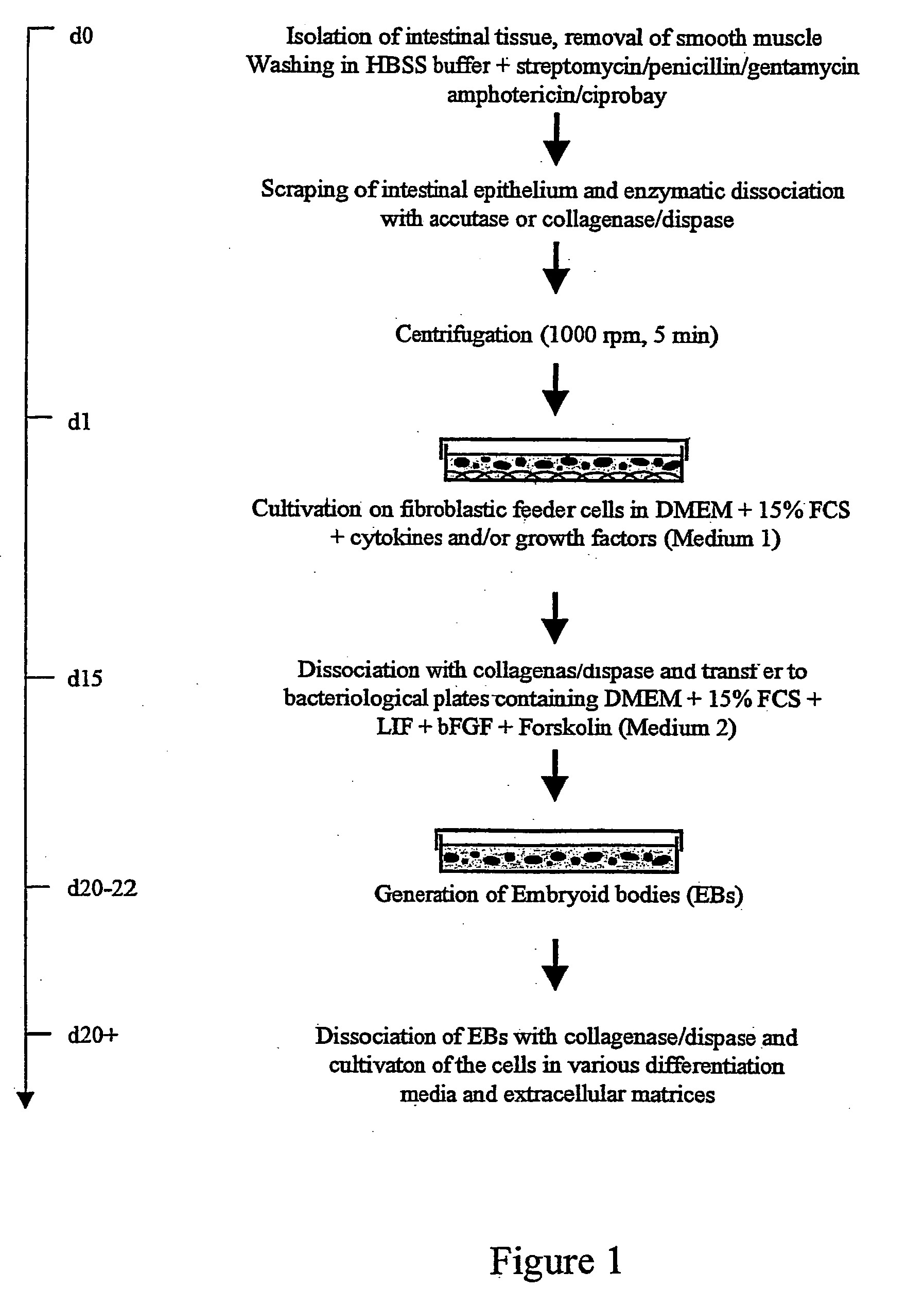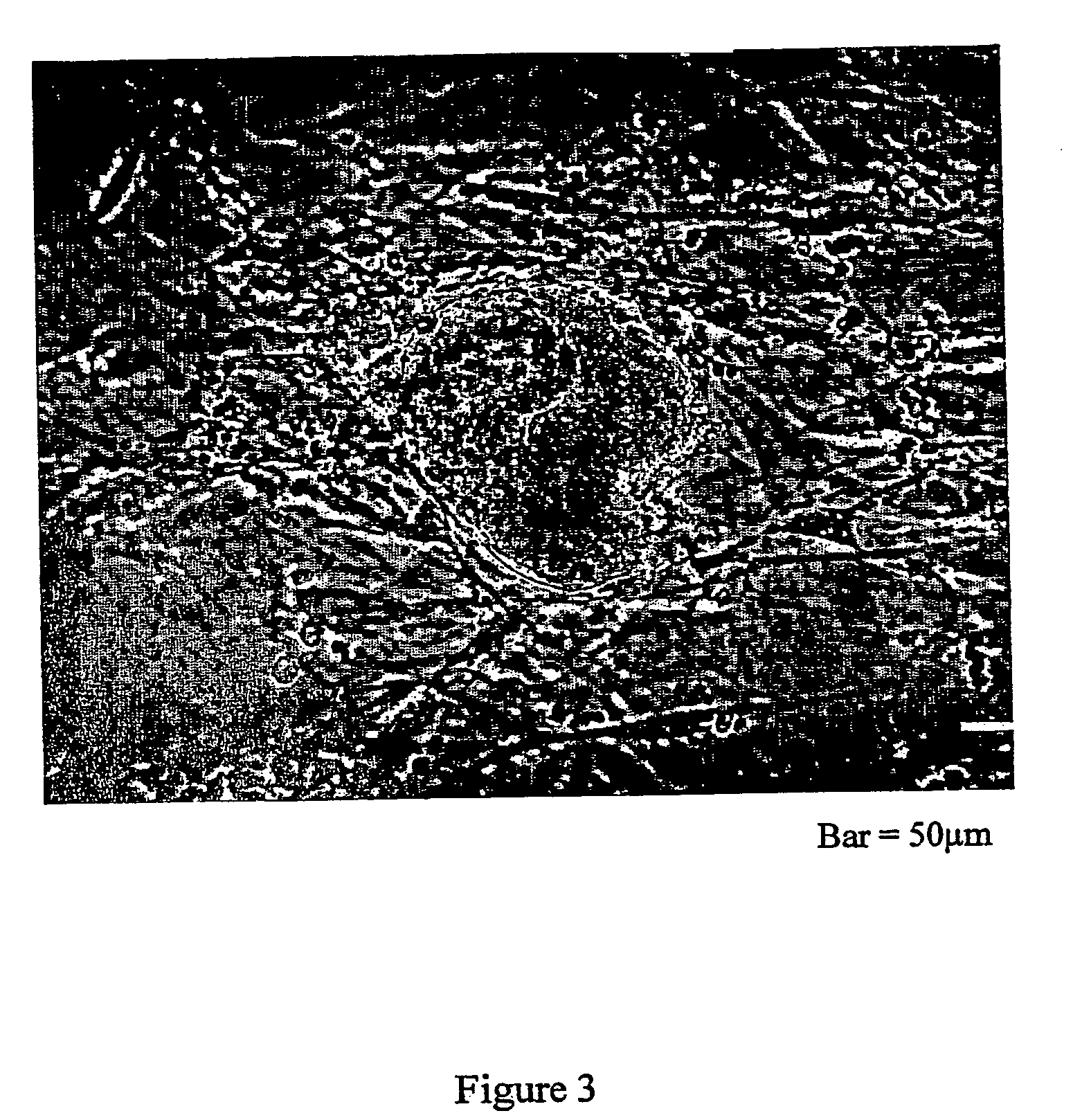Method for isolating, culturing and differentiating intestinal stem cells for therapeutic use
a stem cell and intestinal technology, applied in the field of isolating, culturing and differentiating intestinal stem cells for therapeutic use, can solve the problems of difficult identification and isolation of adult stem cells, no method is currently available in the prior art for the establishment of primary cultures from dissociated cells
- Summary
- Abstract
- Description
- Claims
- Application Information
AI Technical Summary
Benefits of technology
Problems solved by technology
Method used
Image
Examples
example 1
[0102] Isolation of IS cells
[0103] As mentioned above, in a preferred embodiment intestinal stem (IS) cells are harvested from the intestinal epithelium of human or mammalian origin (FIG. 1). For human IS cells, approximately 1 to 10 cm of small intestine was obtained during pancreaticoduodenectomy. The rat is used as model for obtaining IS cells of mammalian origin. Accordingly, the small intestine was isolated by dissection from F-344 inbred rats (Harlan Olac; age: 15-24 weeks). After flushing of lumenal contents with Hanks' balance salt solution (HBSS; Gibco BRL) containing 0.05 U / ml penicillin, 0.05 μg / ml streptomycin, 50 μg / ml gentamycin (Gibco / BRL), 2,5 μg / ml amphotericin (Gibco / BRL), 2 mg / ml ciprobay (Bayer), the smooth muscles surrounding the intestinal epithelium was mechanically removed with a scalpel, and the tissue was cut longitudinally and the pieces were washed up to 10 times in HBSS. The intestinal epithelium was then isolated by scraping and enzymatic dissociation ...
example 2
[0104] Pluripotency of Human and Rat IS Cells Determined by Alkaline Phosphatase (AP) Activity
[0105] As previously described, markers for pluripotent cells are often useful to identify stem cells in cultures. IS cells of rat (FIG. 4) or human (FIG. 11) origin typically manifest AP activity and AP positive cells are typically pluripotent. AP activity has been demonstrated in ES and ES-like cells in the mouse (Wobus et al., 1984, Exp. Cell 152:212-219; Pease et al., 1990, Dev. Biol. 141:322-352), rat (Ouhibi et al., 1995, Mol. Repro. Dev. 40:311-324; Vassilieva et al., 2000, Exp. Cell Res. 258:361-373), pig (Talbot et al., 1993, Mol..Repro. Dev. 36:139-137), cow (Talbot et al., 1995, Mol. Repro. Dev. 42:35-52), and in humans (Thomson et al., 1998, Science 282:1145-1147; Shamblott et al., 1998, Proc. Nat. Acad. Sci. USA 95:13726-13731; Pera et al., 2000, J. Cell Science 113:5-10). AP activity was determined by fixing human or rat IS cells in 4% paraformaldehyde at room temperature for...
example 3
[0107] Pluripotency of Human and Rat IS Cells Determined by Oct-4 Expression, SSEA-1 Expression, or TRA-1-60 Expression.
[0108] Pluripotency of IS cells can also be studied by Oct-4 expression. The transcription factor Oct-4 has been shown to be required for establishing and maintaining the undifferentiated phenotype of ES cells, and plays a major role in determining early events in embryogenesis and cellular differentiation (Pesce et al., 1998, Bioessays 20:722-732). Oct-4 has been shown to be expressed in mouse (Nichols et al., 1998, Cell 95:379-391), rat (Vassilieva et al., 2000, Exp. Cell Res. 258:361-373) and human (Reubinoff et al., 2000, Nature Biotechnol. 18:399-404) ES or EG cells. Oct-4 is also expressed in rat IS cells (FIG. 6), and in human IS cells (FIG. 13a).
[0109] Analysis of Oct-4 gene expression in rat IS cells colonies after cultivation with different variants of cytokines and growth factors at day 9 was performed using a semiquantitative reverse transcription-pol...
PUM
| Property | Measurement | Unit |
|---|---|---|
| Composition | aaaaa | aaaaa |
| Level | aaaaa | aaaaa |
Abstract
Description
Claims
Application Information
 Login to View More
Login to View More - R&D
- Intellectual Property
- Life Sciences
- Materials
- Tech Scout
- Unparalleled Data Quality
- Higher Quality Content
- 60% Fewer Hallucinations
Browse by: Latest US Patents, China's latest patents, Technical Efficacy Thesaurus, Application Domain, Technology Topic, Popular Technical Reports.
© 2025 PatSnap. All rights reserved.Legal|Privacy policy|Modern Slavery Act Transparency Statement|Sitemap|About US| Contact US: help@patsnap.com



